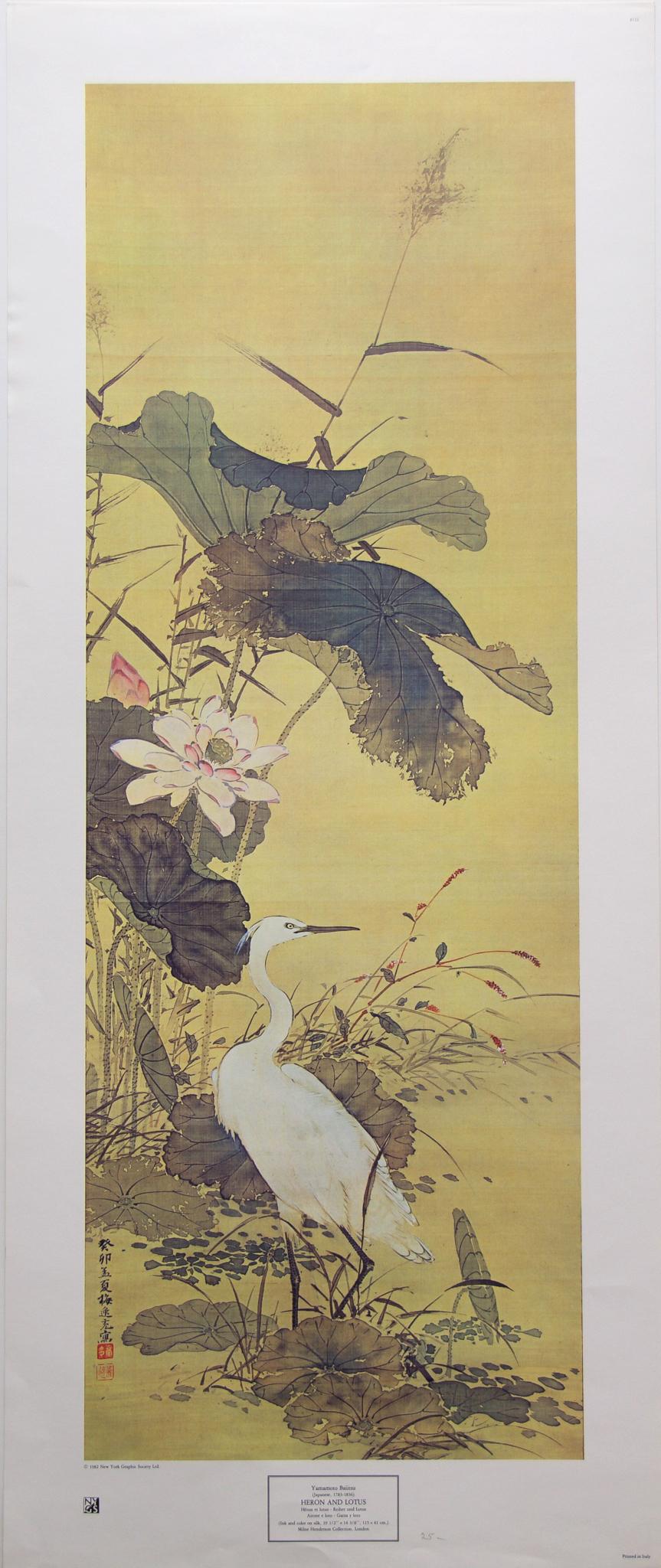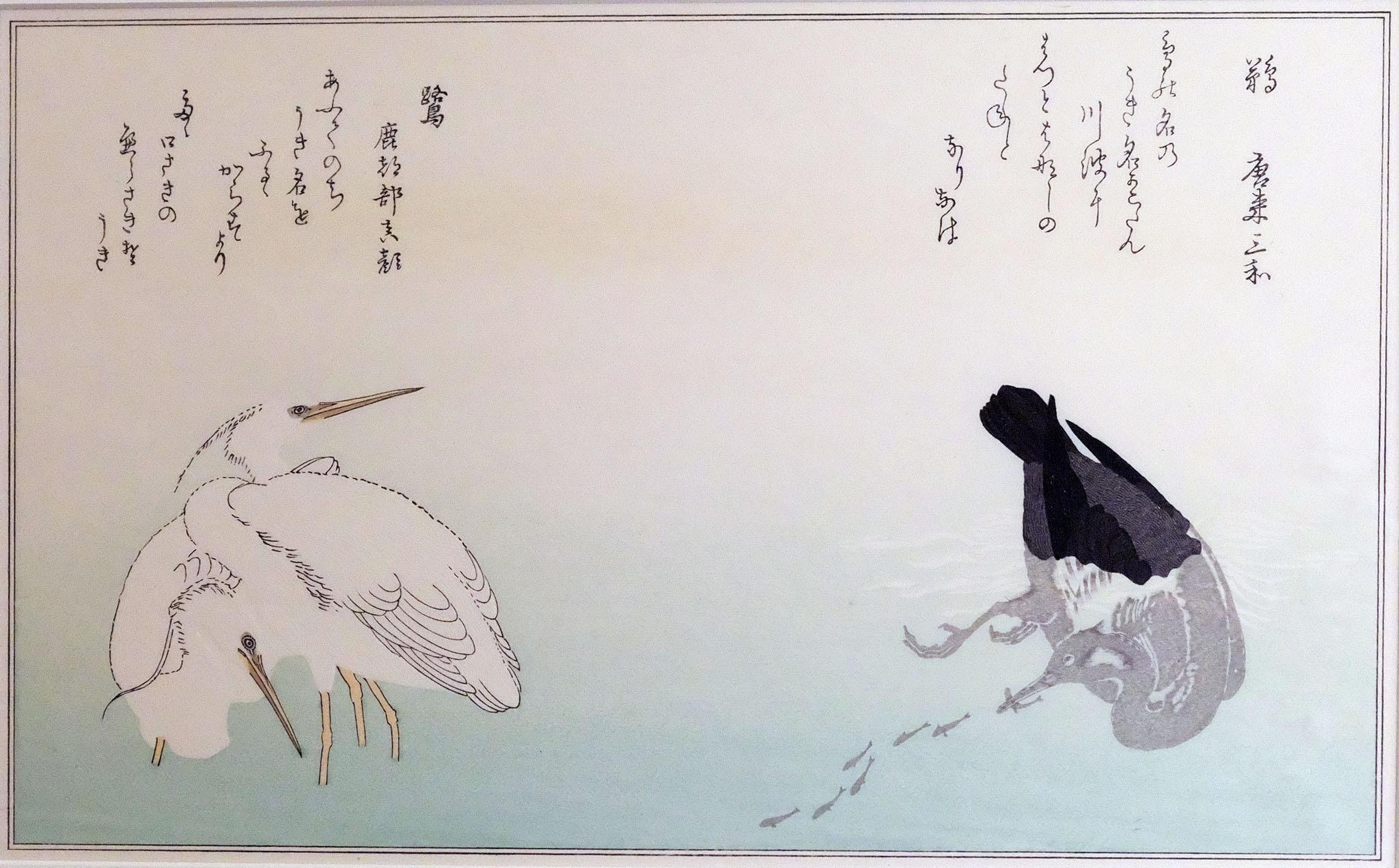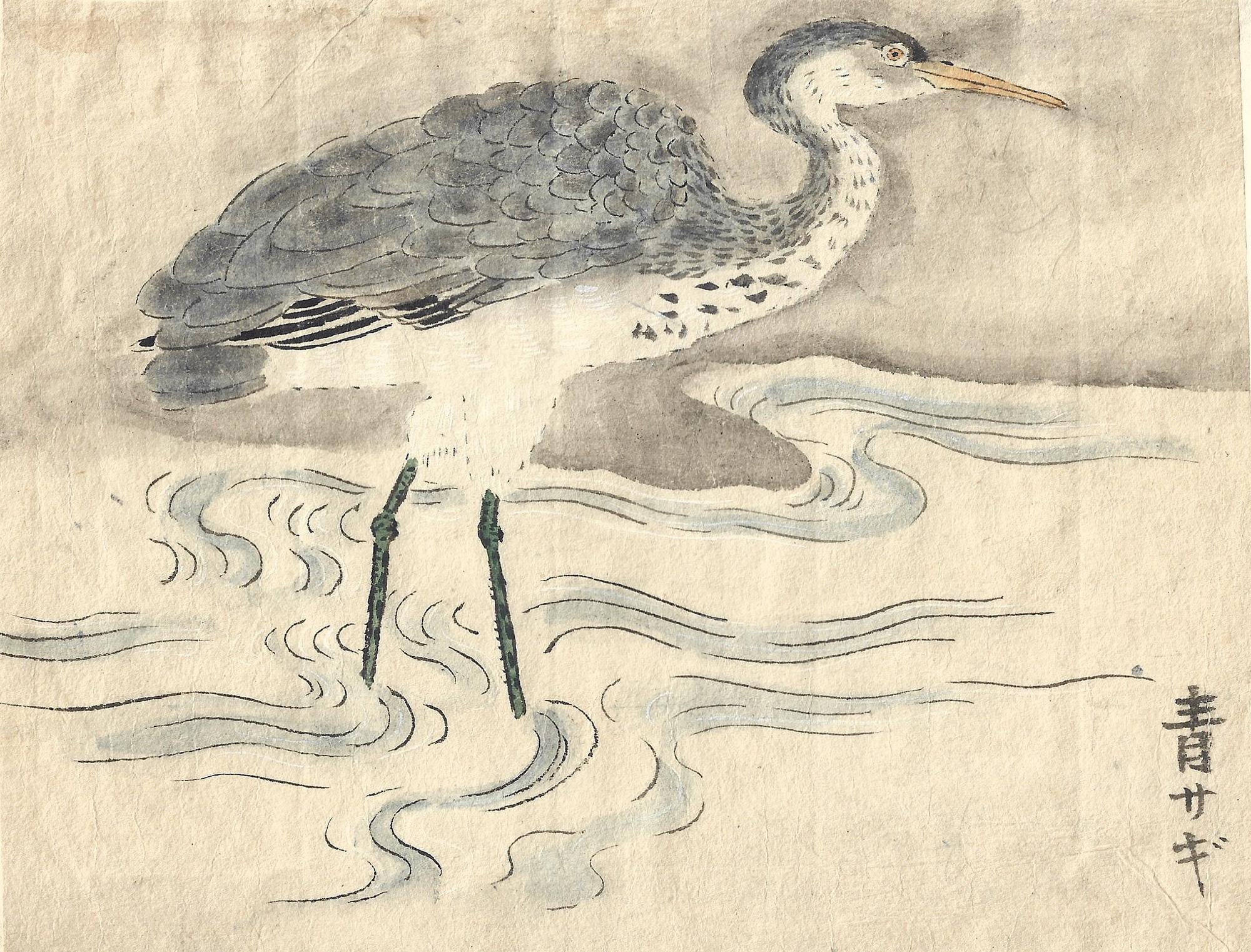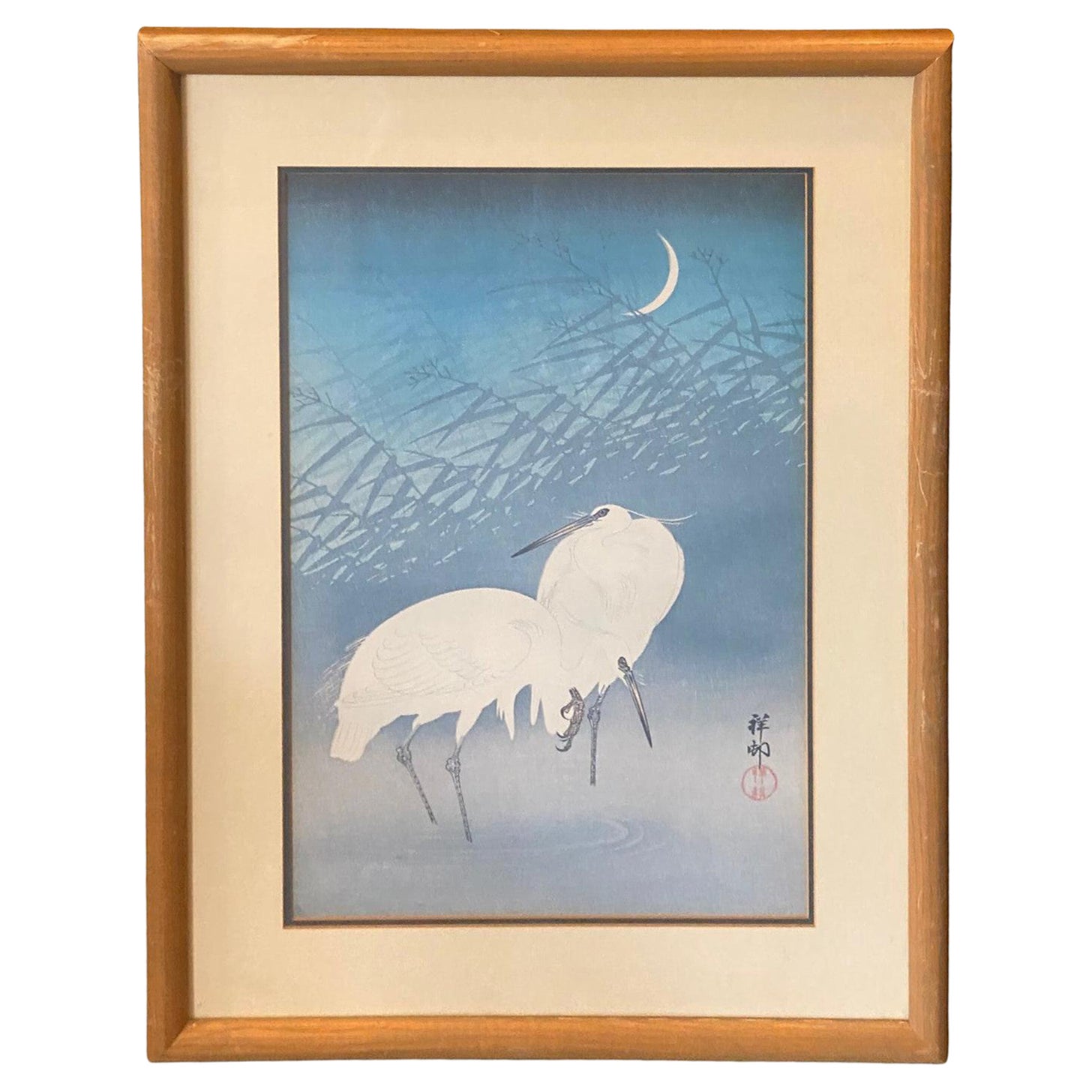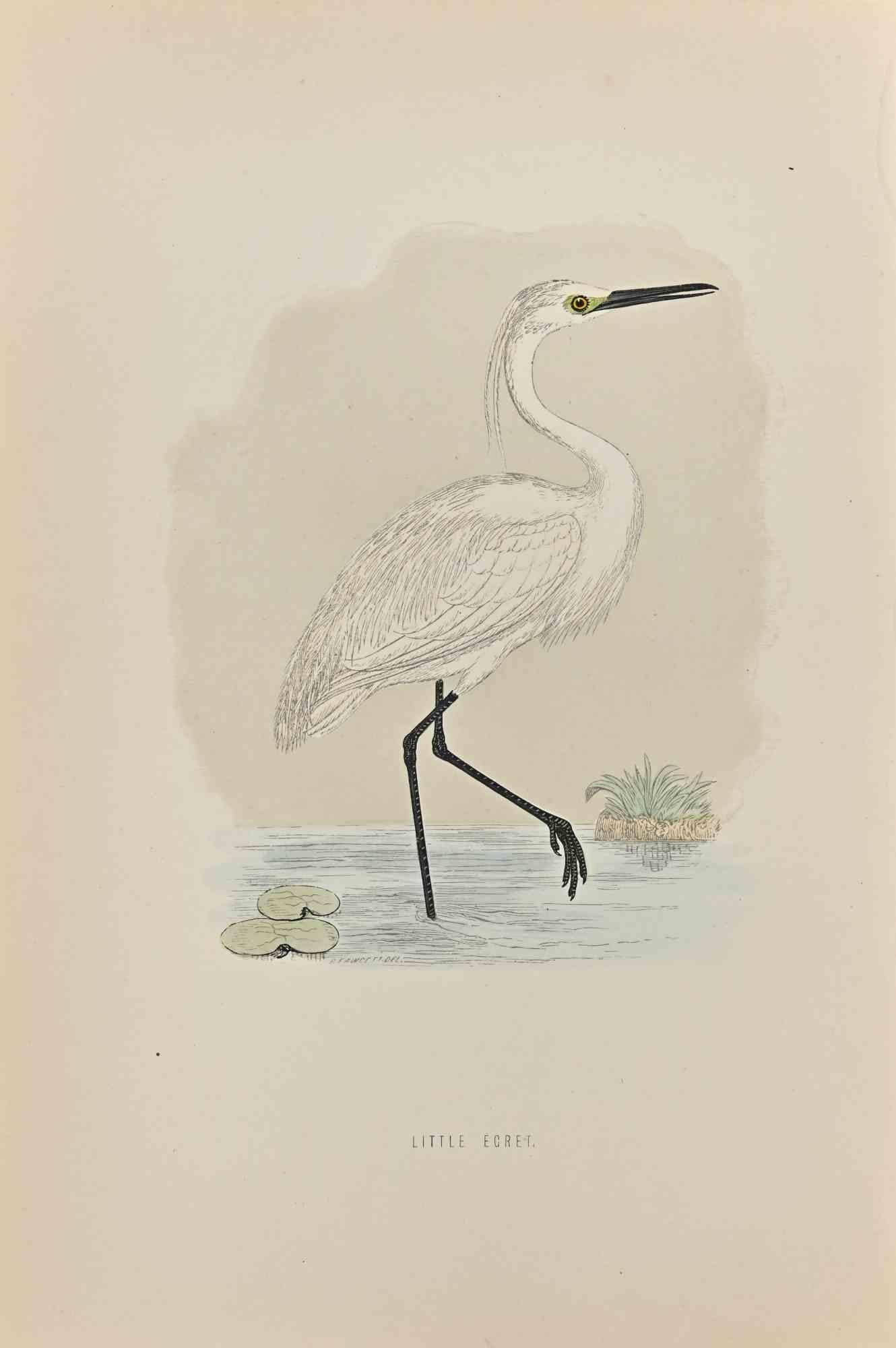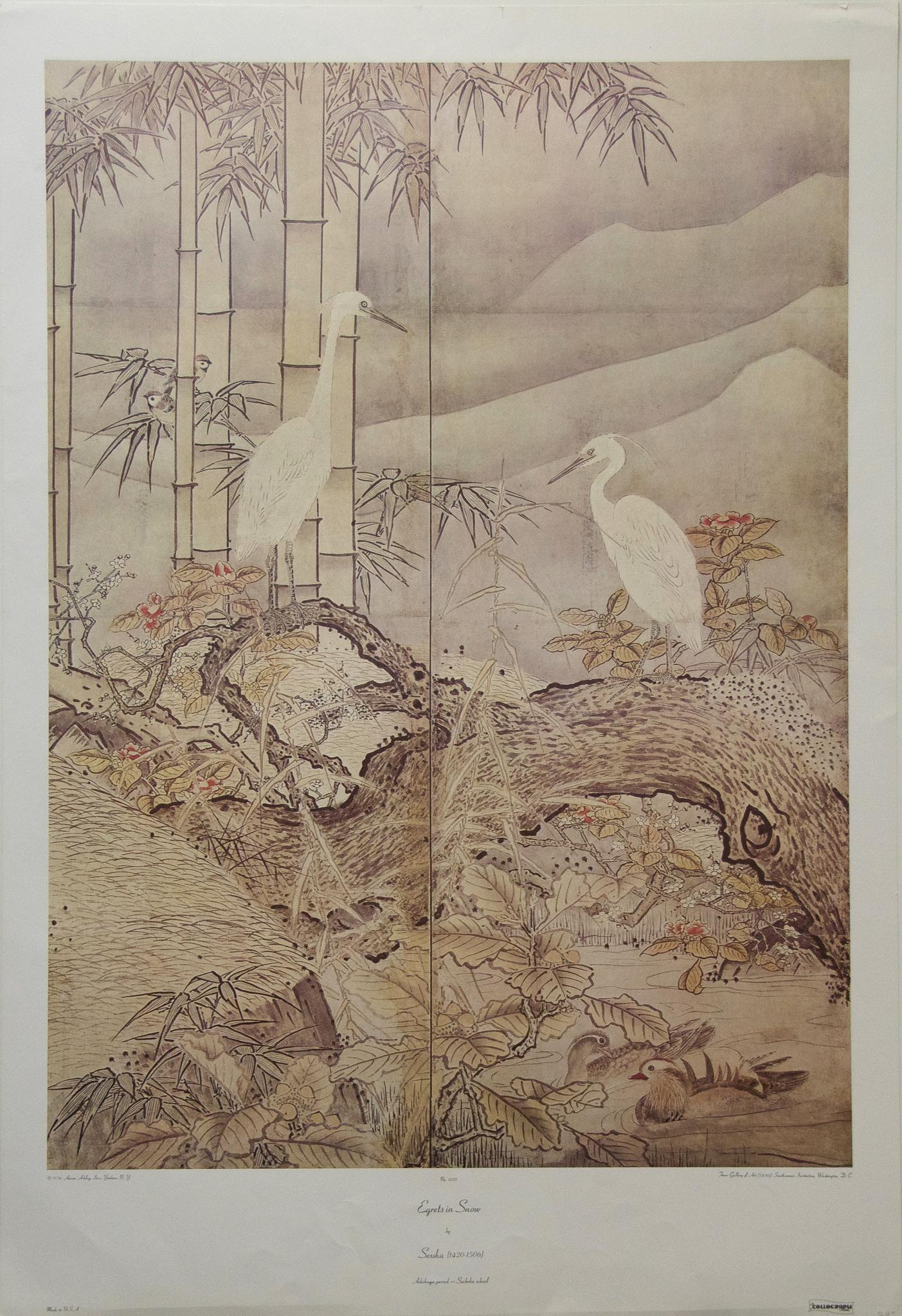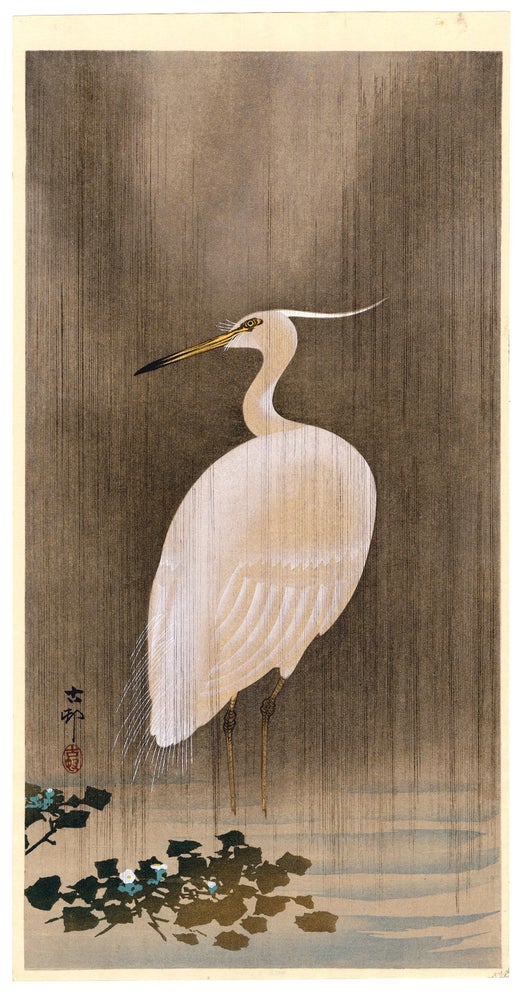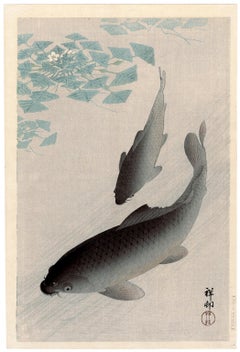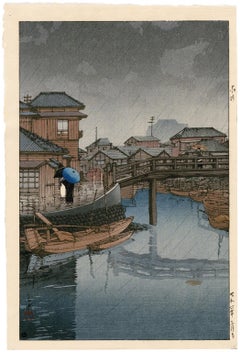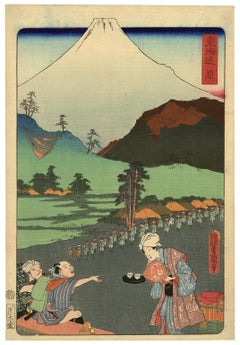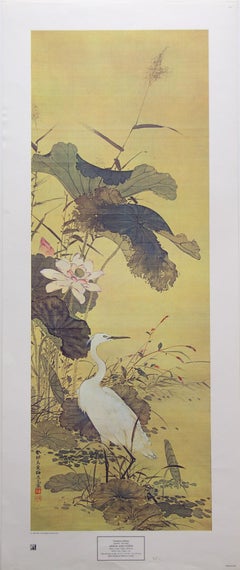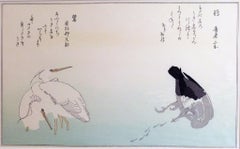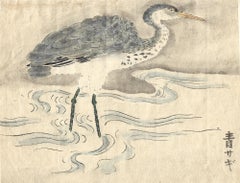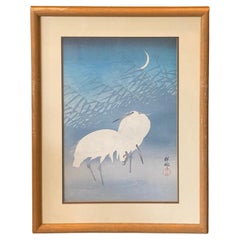Items Similar to 'Wading Egret' — Japanese Woodblock kacho-e
Want more images or videos?
Request additional images or videos from the seller
1 of 3
Ohara Koson'Wading Egret' — Japanese Woodblock kacho-ec. 1900-1910
c. 1900-1910
$1,400
£1,063.13
€1,228.92
CA$1,967.57
A$2,190.88
CHF 1,158.59
MX$26,661.71
NOK 14,604.29
SEK 13,759.39
DKK 9,171.75
About the Item
'Wading Egret', color woodblock, c. 1900 - 1910. Signed 'Koson' in black ink with the artist’s red seal beneath, lower left. A superb, skillfully-inked impression, with fresh colors, on cream wove Japan paper; the full sheet with margins, in excellent condition. Stamped MADE IN JAPAN in the bottom center margin, verso. Published by Daikokuya. Archivally sleeved, unmatted.
Image size 13 11/16 x 7 1/8 (348 x 181 mm). Sheet size: 14 3/8 x 7 1/2 inches (365 x 190 mm).
Provenance: Robert O. Muller Estate.
Literature: 'Crows, Cranes & Camellias: The Natural World of Ohara Koson', Newland, Amy R.: Jan Perree & Robert Schaap, Leiden: Hotei Publishing, 2001, pg 82, pl. 61.
Collection: Museum of Fine Arts, Boston
.
ABOUT THE ARTIST
Koson Ohara (also Shoson and Hoson, 1877-1945) is the most renowned Japanese artist of early 20th-century kacho-e (bird-and-flower pictures) woodblock printmaking. With meticulous detail, sensitive color, and a palpable reverence for flora and fauna, Koson brought the genre into the modern era.
Koson was born in Kanazawa with the given name Matao Ohara. He began his artistic career studying painting under the Shijo-style master Kason. Around the turn of the century, Koson became a teacher at the Tokyo School of Fine Arts, where he met Ernest Fenollosa, an American collector, scholar, and admirer of Japanese art and culture. Around 1905, Koson started to produce woodblock prints. Fenollosa, the curator of Japanese Art at the Museum of Fine Arts, Boston, and an adviser to the National Museum of Modern Art in Tokyo, persuaded Koson to export his bird prints to American art collectors.
Between 1900 and 1912, Koson worked with several different publishers and designed a series of Russo-Japanese War prints, as well as genre landscapes, but his passion remained with kacho-e. His earliest and rarest designs are notable for their narrow formats and soft colors. All his woodblock prints were signed or sealed Koson—most of them published by Kokkeido and Daikokuya. After 1912, he changed his name to Shoson and dedicated himself to painting. Ten years later, Koson returned to printmaking, and in 1926, he began designing woodblock prints for the esteemed Shin Hanga publisher Shozaburo Watanabe. Koson changed his name again, this time to Hoson when he produced designs collaboratively published by Sakai and Kawaguchi around 1930. He also served as an adviser to the National Museum of Modern Art in Tokyo.
Koson’s prints can be found in many major museums worldwide, including the British Museum, Brooklyn Museum, Freer Gallery, Harvard Art Museums, LACMA collections, Museum of Fine Arts, Boston, and the Metropolitan Museum of Art.
- Creator:Ohara Koson (1877 - 1945, Japanese)
- Creation Year:c. 1900-1910
- Dimensions:Height: 13.69 in (34.78 cm)Width: 7.13 in (18.12 cm)
- Medium:
- Movement & Style:
- Period:
- Condition:
- Gallery Location:Myrtle Beach, SC
- Reference Number:Seller: 981891stDibs: LU532312492992
Ohara Koson
Ohara Koson was a prolific printmaker of the 20th century widely known for his kacho-ga, bird and flower prints. During his study with Kason, he took his artist name Koson, a partial adaptation of his teacher's name. Early in his career, many of Koson’s prints were muted in color and captured a sense of calmness and elegance. Koson’s depiction of birds are very realistic, the details of body and feathers in particular were always depicted with meticulous care.
About the Seller
5.0
Recognized Seller
These prestigious sellers are industry leaders and represent the highest echelon for item quality and design.
Platinum Seller
Premium sellers with a 4.7+ rating and 24-hour response times
Established in 1995
1stDibs seller since 2016
311 sales on 1stDibs
Typical response time: 1 hour
Associations
International Fine Print Dealers Association
- ShippingRetrieving quote...Shipping from: Myrtle Beach, SC
- Return Policy
Authenticity Guarantee
In the unlikely event there’s an issue with an item’s authenticity, contact us within 1 year for a full refund. DetailsMoney-Back Guarantee
If your item is not as described, is damaged in transit, or does not arrive, contact us within 7 days for a full refund. Details24-Hour Cancellation
You have a 24-hour grace period in which to reconsider your purchase, with no questions asked.Vetted Professional Sellers
Our world-class sellers must adhere to strict standards for service and quality, maintaining the integrity of our listings.Price-Match Guarantee
If you find that a seller listed the same item for a lower price elsewhere, we’ll match it.Trusted Global Delivery
Our best-in-class carrier network provides specialized shipping options worldwide, including custom delivery.More From This Seller
View All'Carp and Water Chestnut' — Showa lifetime impression
By Ohara Koson
Located in Myrtle Beach, SC
Ohara Koson (1877-1945), 'Carp and Water Chestnut', color woodblock print, 1926. A fine impression, with fresh colors, on cream Japan paper; the full sheet, in excellent condition.
Signed 'Koson' with the artist’s red seal 'Koson'. Published by Watanabe Shozaburo. With the Watanabe 'C' seal in the lower right margin, indicating a lifetime impression printed between 1929-1942.
Image size 13 1/2 x 7 1/4 inches (343 x 184 mm); sheet size 14 1/2 x 7 1/2 inches (368 x 191 mm). Archivally sleeved, unmatted.
Literature: 'Crows, Cranes, and Camellias: The Natural World of Ohara Koson', Newland, Amy R.: Jan Perree & Robert Schaap, Leiden: Hotei Publishing, 2001. S39.1, pl 169.
Collections: National Museum of Asian Art (Smithsonian), Smart Museum of Chicago (University of Chicago).
In Japanese art, the carp represents good luck and good fortune.
ABOUT THE ARTIST
Koson Ohara...
Category
1920s Showa Animal Prints
Materials
Woodcut
'Lakeside Shower, Matsue' — Showa-era Woodblock Print
By Kawase Hasui
Located in Myrtle Beach, SC
Kawase Hasui, 'Chihan no Ame, Matsue' (Lakeside Shower, Matsue), color woodblock print, 1932. A fine, atmospheric impression, with fresh colors; the full sheet, from a postwar editio...
Category
1930s Showa Figurative Prints
Materials
Woodcut
'Rain at Shinagawa, Ryoshimachi' — Showa-era Woodblock Print
By Kawase Hasui
Located in Myrtle Beach, SC
Kawase Hasui, 'Rain at Shinagawa, Ryoshimachi' from the series 'Selection of Views of the Tokaido', woodblock print, 1931. A very fine, atmospheric impression, with fresh colors; the...
Category
1930s Showa Figurative Prints
Materials
Woodcut
'Tokaido' — Mt. Fuji Rising – Mid-Nineteenth Century Woodblock Print
By Utagawa Kunisada (Toyokuni III)
Located in Myrtle Beach, SC
Utagawa Kunisada (Tokoyuni III), 'Tokaido', color woodblock, 1863. Signed in the cartouche, lower right. A fine impression, with rich, fresh colors and pronounced woodgrain, the full...
Category
1860s Edo Figurative Prints
Materials
Woodcut
Kintai Bridge at Iwakuni in Suo Province (Suo iwakuni kintai-bashi), 1859
By Hiroshige II
Located in Myrtle Beach, SC
Utagawa Hiroshige II (1829-1869), 'Kintai Bridge at Iwakuni in Suo Province' (Suo iwakuni kintai-bashi), from the series 'One Hundred Views of Famous Pla...
Category
1850s Edo Landscape Prints
Materials
Woodcut
Japanese Kimono Fabric Design — Vintage Color Woodblock Print
Located in Myrtle Beach, SC
Anonymous, Japanese Kimono Fabric Design, color woodcut, c. 1930. A superb impression, with fresh colors, fine graduations, and metallic gold motifs, on ...
Category
Early 1900s Showa Figurative Prints
Materials
Woodcut
You May Also Like
"Heron and Lotus" by Yamamoto Baiitsu. Lithograph Printed in Italy.
Located in Chesterfield, MI
New York Graphic Society, 1982.
Printed in Italy
Good/fair Condition - Minimal creasing pictured in corners.
39 in x 16 in.
Category
20th Century Animal Prints
Materials
Lithograph
"Cormorant and Egret" Japanese Woodblock Print of Birds in Water & Nature Poem
By Kitagawa Utamaro 1
Located in Austin, TX
Artist: Kitagawa Utamaro the First (Japanese, 1753 - 1806)
Publisher: Tsutaya Jūzaburō (Japanese, 1750 - 1797)
Page Size: 10 x 15 in.
Frame Size: 16 x 22 in.
An Edo Period color woo...
Category
1790s Animal Prints
Materials
Paper, Woodcut
A heron fishing – Edo School, 19th century
Located in Middletown, NY
Ink and watercolor on fibrous Japon paper laid down to period cream laid paper, 6 x 7 1/2 inches (155 x 190 mm). Minor toning and some insect damage on the mount, painting itself rem...
Category
Mid-19th Century Edo Animal Drawings and Watercolors
Materials
Ink, Watercolor, Handmade Paper, Laid Paper
Ohara Koson Signed Framed Japanese Asian Print Egrets and Crescent Moon
By Ohara Koson
Located in Studio City, CA
A wonderfully composed and beautifully colored print by famed Japanese artist Ohara Koson (Ohara Hōson, Ohara Shōson) titled "Egrets and Crescent Moon" (sometimes referred to as Two ...
Category
20th Century Japanese Showa Prints
Materials
Wood, Paper
Little Egret - Woodcut Print by Alexander Francis Lydon - 1870
Located in Roma, IT
Little Egret is a modern artwork realized in 1870 by the British artist Alexander Francis Lydon (1836-1917).
Woodcut print on ivory-colored paper.
Hand-colored, published by London...
Category
1870s Modern Figurative Prints
Materials
Woodcut
"Egrets in the Snow" by Sesshu Toyo
Located in Chesterfield, MI
Lithograph measures 38 x 26 inches.
Good/Fair, slight creasing at bottom of lithograph.
Category
15th Century and Earlier Animal Prints
Materials
Lithograph
$160 Sale Price
20% Off
More Ways To Browse
Antique Japanese Art
20th Century Japanese Woodblock
Antique Crow
Wading Birds
Egret Bird
Japanese Woodblock Flower Prints
Antique Japanese Bird Prints
Woodblock Bird Prints
Japanese Woodblock Prints Birds
Crane Bird Painting
Japanese Woodblock Animal
R A Muller
Hotei Japan
Watanabe Woodcut
Antique Camellia Print
Woodblock Crow
Koson Ohara
Audubon Engraving
